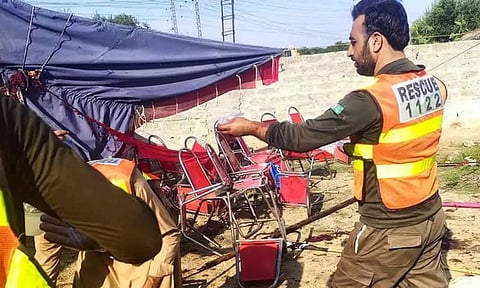

By Zia Ur Rehman
WASHINGTON: With the death toll for the most recent suicide bombing climbing past 50 in Pakistan, the head of Jamiat Ulema Islam (JUI-F) party, whose supporters were targeted in the blast, decried the country’s security forces over the apparent “intelligence failure.” “Where are they? When will they listen to us? When will they heal our wounds? When will they establish a system that safeguards our future generations?” JUI-F leader Fazl-ur-Rehman asked on Twitter. The conservative preacher is not the only one in Pakistan raising his voice against the rise of terrorist attacks, including suicide bombings.
The Sunday blast in Bajaur was claimed by a local affiliate of the “Islamic State” militia. The “Islamic State Khorasan” (ISIS-K) accuses JUI-F of hypocrisy for being an Islamic political group that has supported secular governments and the military. But other extremist groups are also using suicide to target their political enemies in Pakistan. The nation experienced more than a dozen suicide attacks in the first half of 2023, according to report by the Pakistan Institute for Conflict and Security Studies, an Islamabad-based security think-tank. This also includes a bombing in a Peshawar mosque that killed over 100 people. A commander of the Tehreek-e-Taliban Pakistan (TTP), initially claimed responsibility, but this was later denied by a TTP spokesman.
Organised suicide terrorism in Pakistan took root after a military operation against militants sheltered in Islamabad’s radical Red Mosque in June 2007. The siege culminated in a deadly battle, with more than 100 militants and at least 11 law enforcement members losing their lives. Several months later, the TTP appeared on the scene as a formidable militant outfit.
“This marked a significant turning point in Pakistan’s history, as the TTP began a series of suicide attacks that terrorised the nation for years,” said Fakhar Kakakhel, a Peshawar-based journalist who covered Islamist militancy extensively. “The suicide bombings targeted military, government installations, public places and civilian gatherings, instilling fear and chaos in society.” Attacks quickly grew more frequent, with former Prime Minister Benazir Bhutto dying in a suicide attack on December 2007. The background of her assassination was never fully made clear.
In 2008, Pakistani officials noted 59 suicide attacks in the country, with more total casualties from such attacks than Afghanistan and Iraq had that same year. The numbers remained high for several years after that. In 2014, the military launched a major military operation known as “Zarb-e-Azb,” aimed to eradicate TTP and other al-Qaida-linked militant groups. In the years that followed, Pakistan has experienced fewer suicide attacks, with the numbers dropping into single digits around the turn of the decade. Namely, officials noted four, three and five suicide attacks occurring in 2019, 2020 and 2021, respectively, according to the Pakistan Institute for Peace Studies.
“Until late-2020, TTP had been crumbling under Pakistan’s sustained Zarb-e-Azb operation, the deaths of successive leaders by US drone strikes and an internal rift that steadily pushed factions of the terror organisation to relocate to neighboring Afghan provinces,” journalist Kakakhel said.
With the rise of the Taliban government in Afghanistan in August 2021, however, the TTP has resurfaced as a serious threat. “Since the reunification with several splinter groups, TTP has aspired to reestablish control of territory in Pakistan after being emboldened by the Taliban takeover in Afghanistan,” according to the UN Security Report on July 25.